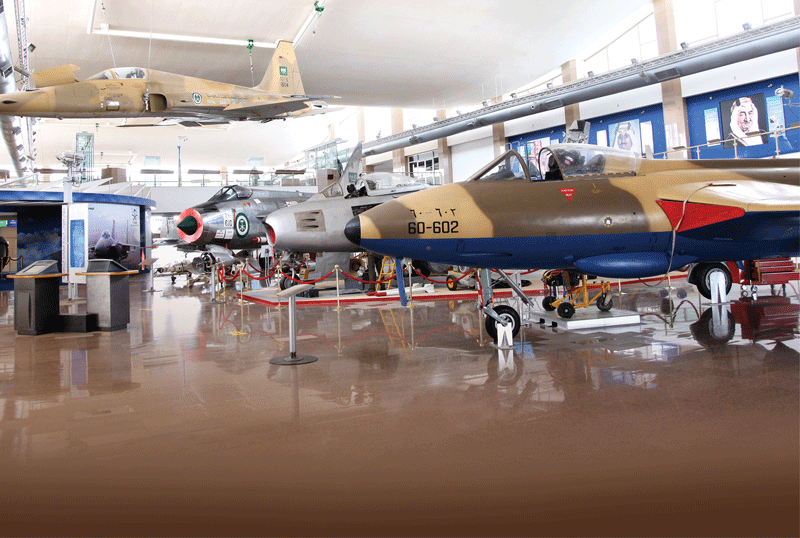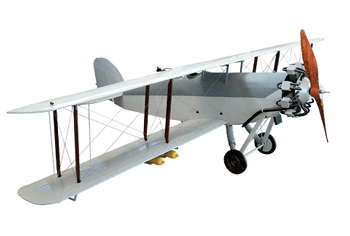
Saqr Aljazeera Aviation Museum
Vintage Aircraft on Display
 |
Ghazanfar Ali Khan
One of the most educative and enjoyable, but least known tourist spot in the Saudi capital Riyadh, is aviation museum.
This museum is a truly hands-on experience. The Saqr Aljazeera museum has many high-value aviation exhibits and vintage aircrafts with cockpits available for a visitor to actually sit inside. In fact, a visit to the museum today will be a memorable and educational time out for any visitor including families and children.
On visiting the aviation museum, you can learn about the whole variety of exhibits, their various operational roles in the Saudi aviation history, besides having an insight into the local aviation heritage. Located close to the airport, any one can catch a glimpse of the imposing museum on the Eastern Ring Road near Exit 10, the road which goes straight to the King Khalid International Airport in Riyadh.
Put together by the Royal Saudi Air Force, with help from defense firm BAE Systems, it is a museum dedicated to about 100 years of Saudi aviation history in all of its aspects. Hence, my advice is to visit the museum. It’s a pleasant way to spend an afternoon looking at various aircraft including a range of aviation-related exhibits from the olden days’ aviation to the present day Saudi nation.
The museum, commonly known as the aviation museum is a must-see site for one and all, especially for aspiring aircraft and aeronautical engineers. The museum’s tour gives a history of the Royal Saudi Air Force. The museum narrates how late King Abdulaziz started the aviation saga in Saudi Arabia with about five airplanes until they reached to hundreds of the most powerful aircraft in the world.
The museum, a rich storehouse for vintage aviation objects and aircrafts, started operations in 1999, coinciding with the Riyadh’s 100th anniversary celebrations. The museum is well maintained and the staffers are very friendly. There are a large number of objects currently featured in the museum including an education center, an aircraft maintenance center and a large ground for big-size vintage planes.
There is a famous Lockheed Tristar, belonging to the state-owned Saudia, on display. As someone drives along the Airport Road, he can see the wings of the Tristar beside the road. There are various types of military air crafts on display including Boeing, BAC Lightning, Lockheed, Douglass, Cessna and Panavia. They also have collections of missiles, ammunition, air force uniforms, space suit and miniature planes.
Containing a mixture of models and real aircraft including a number of planes previously in use by the Royal Saudi Air Force--together with explanatory videos (in English and Arabic), equipment from the planes, simulators and instrumentation – its prized possession is the now fully restored Dakota DC3 (SA-R-1). It was presented to late King Abdulaziz by US President Roosevelt and on which visitors are allowed to climb aboard.
 The prevailing theme throughout is how the RSAF developed from flying a few bi-planes to a force, which operates some of the most modern aircraft in the world today. Throughout the museum, there are interactive video screens that allow visitors to explore this history for themselves and to understand the rapid march of Saudi aviation sector—rather from a desert nation to a modern state.
The prevailing theme throughout is how the RSAF developed from flying a few bi-planes to a force, which operates some of the most modern aircraft in the world today. Throughout the museum, there are interactive video screens that allow visitors to explore this history for themselves and to understand the rapid march of Saudi aviation sector—rather from a desert nation to a modern state.
There are also documents and photographs that reflect the initial stages of the unification of the Kingdom of Saudi Arabia under late King Abdulaziz. It is literally a museum with something for everyone including a ‘white-knuckle ride’ near the exit where you are invited to travel into space on a simulator which throws you about as you navigate black holes and avoid a few passing asteroids!
In fact, a Saudia Lockheed L-1011 Tristar serves as a gateguard at the entrance of the museum visible from the ring road. The SA plane you see is part of the museum, which which houses the Royal Saudi Air Force’s military planes, helicopters, fighters, bombers, and missile launchers. There are more planes on the vicinity if you only look closer. One can see several families on any day roaming around the museum. There are also students, probably coming for their school field trip.
The museum is on expansion course. The building which is standing just behind the airplane from the side of the road is only a third of the grand project for this place. In the museum, there are areas to view 5-minute films showcasing the best of the Saudi Hawks, the Air Force’s aerobatics team. There is also a video on how the Air Force do their rescue operations.
In fact, the planes exhibited in the museum are not only available for viewing. They are also available for boarding. Unlike some museums where you can only gaze at the stuff displayed, the museum here is sort of interactive. A visitor or a group of visitors to the museum can have a blast taking turns in the cockpit of this rescue helicopter.
There is also a corner devoted to spacecrafts. There are also pins and souvenirs commemorating the journeys of Arabs in space. Then, the visitors can go out of the main museum building to check out the bigger planes. The huge expanse of land is home to several military aircraft and an airbus. A huge plane along with some other little ones are parked at the back of the museum grounds.
There are even free brochures and booklets about the museum. The museum is affiliated to the Ministry of Defense, and it highlights the cultural and historical aspect of the Royal Saudi Air Force (RSAF). It displays the historical evolution of RSAF its inception over 75 years ago. It contains real aircrafts, their scale models, photographs, and documents.
This historical period of the museum is divided into five phases: The pre-establishment phase started in 1914 and ended in 1925. The establishment phase of the museum started in 1925 and ended in 1954, while the developmental phase started in 1954 and ended in 1962. It was way back in 1982, when the renovation and building phase of the museum started.
The first phase work was completed with the establishment of the museum, which includes interior galleries containing the old and new aircrafts and air defense weapons, in addition to a ‘Space’ corner containing the devices and equipment needed for a spaceflight. The museum involves computers to be used by visitors to enhance their knowledge of the aircraft, as well there are pavilions showing historical documentaries, an open-air exhibition area that displays airplanes in their real size with large scale equipment.
In the future phases, it is expected to include - a mosque, a conference hall, other galleries, a cultural center provided with 3-D screen, a library, an education center, and an aircraft maintenance center for the exhibited equipment in the museum.